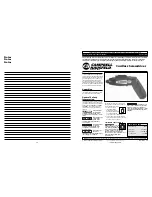
Page 74
EA Elektro-Automatik GmbH
Helmholtzstr. 31-37 • 41747 Viersen
Germany
Fon: +49 2162 / 3785-0
Fax: +49 2162 / 16230
www.elektroautomatik.de
PSI 9000 DT Series
4.3.3.1
Calibrating the set values
►
How to calibrate the voltage
1.
Connect a multimeter to the DC output. Connect a load and set its
current to approx. 5% of the rated current of the power supply, in this
example ≈3 A, and 0 V, if the load is electronic.
2.
In the display tap MENU, then „
General Settings
“, then go down to
“
Calibrate device
” and then tap
START
.
3.
In the next screen select
Voltage calibration
, then
Calibrate output
val.
and
NEXT
. The power supply will switch the DC output on, set a
certain output voltage and show the measured value as
U-mon
.
4.
The next screen requests you to enter the measured output voltage from the multimeter in
Measured value=
.
Tap the value to make a keypad appear and use it to enter the new value. Assure yourself the value is cor-
rect and submit with
ENTER
.
5.
Repeat point 4. for the next three steps (total of four steps).
►
How to calibrate the current
1.
Set the load to approx. 102% nominal current of the PSI device. For the sample model with 60 A this would
be 61.2 A, rounded to 61 A.
2.
In the display tap MENU, then „
General Settings
“, then go down to “
Calibrate device
” and then tap
START
.
3.
In the next screen select
Current calibration
, then
Calibrate output val.
and
NEXT
. The device will switch
the DC output on, set a certain current limit while being loaded and show the measured output current as
I-mon
.
4.
The next screen requests you to enter the output current in
Measured value=
, as measured with the shunt.
Tap the value to make a keypad appear and use it to enter the new value. Assure yourself it’s correct and
submit with
ENTER
.
5.
Repeat point 4. for the next three steps (total of four steps).
4.3.3.2
Calibrating the remote sensing
In case you are generally using the remote sensing feature, it’s recommended to also readjust its measuring circuit
for best results. The procedure is identical to the calibration of voltage, except for it requires to have the sensing
connector (Sense) on the rear to be plugged and connected with correct polarity to the DC output of the PSI.
►
How to calibrate the remote sensing voltage
1.
Connect a load and set its current to approx. 5% of the rated current of the power supply, in this example ≈3
A, and also set 0 V, if the load is electronic. Connect the remote sensing input (Sense) to the DC terminal
of the load with correct polarity and connect a multimeter there in parallel.
2.
In the display tap MENU, then „
General Settings
“, then go down to “
Calibrate device
” and then tap
START
.
3.
In the next screen select
Sense volt. calibration
, then
Calibrate output val.
and
NEXT.
4.
The next screen requests you to enter the measured sensing voltage from the multimeter in
Measured
data=
. Tap the value to make a keypad appear and use it to enter the new value. Assure yourself the value
is correct and submit with
ENTER
.
5.
Repeat point 4. for the next three steps (total of four steps).
4.3.3.3
Calibrating the actual values
The actual values of output voltage (with and without remote sensing) and output current are calibrated almost
the same way as the set values, but here you don’t need to enter anything, you would only confirm the displayed
values. Please proceed the above steps and instead of “
Calibrate output val.
” select “
Calibrate actual val.
” in
the submenus. After the device shows the measured value on display, wait at least 2 seconds for the value to settle
and then tap
NEXT
until you are through all steps.
Содержание PSI 9000 DT Series
Страница 2: ......



































